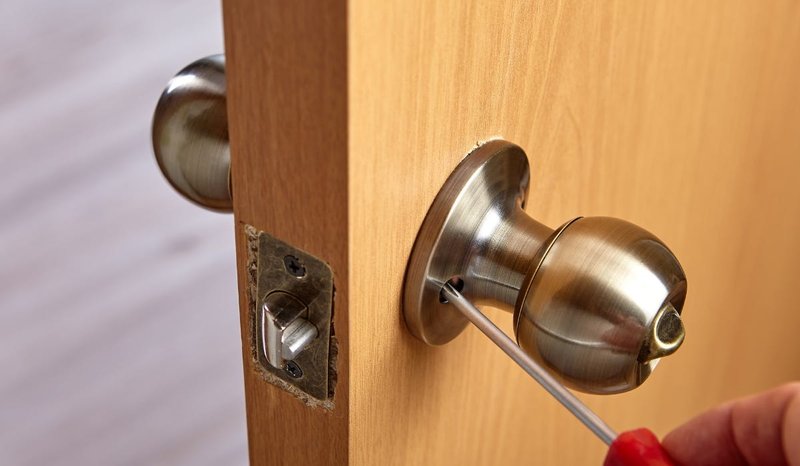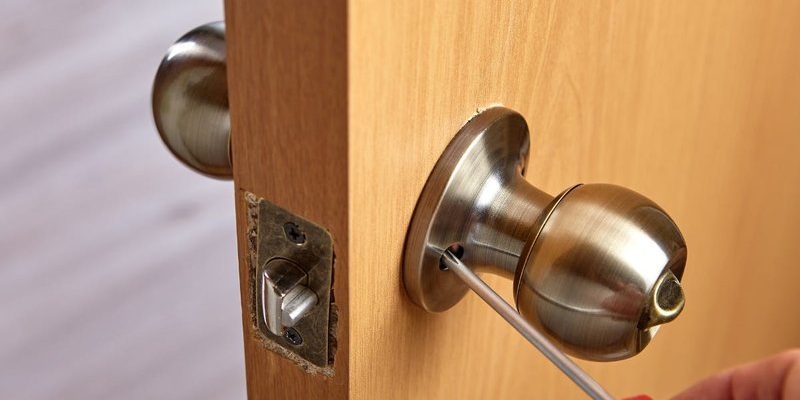
Honestly, it can be kind of alarming the first time you go to unlock your Kwikset or Schlage deadbolt on a freezing morning and the key refuses to budge. Is your hardware broken? Is something wrong with the door itself? Or is this just one of those weird things that happens when winter arrives? Let’s explore what’s really going on when your wood door hardware stiffens up in the cold.
How Temperature Swings Affect Wood Doors and Hardware
The heart of the problem is that wood is always changing with the weather. Walk through any house in winter, and you might hear doors creak or groan a little. That’s not your imagination—wood literally expands and contracts depending on the humidity and temperature in the air. When it gets cold, the moisture in wood evaporates out and the fibers contract, making the door slightly smaller and stiffer.
Metal hardware, like your lockset or latch, is a totally different beast. It contracts in cold too, but not in the same way as wood. Suddenly, you’ve got two materials trying to move in their own directions—with tight tolerances. The result? Hardware that used to fit perfectly might now be just a little bit out of alignment, making every turn feel sticky or stiff.
Here’s the thing: even a tiny shift (we’re talking fractions of a millimeter) between the door and the frame can cause problems. Locks start to drag across their strike plate, latches don’t line up, and handles can feel stuck. If you’ve ever tried to “sync” a universal remote with a stubborn old TV, you know how frustrating it can be when the pieces just won’t talk to each other.
Why Moisture and Humidity Levels Matter
Humidity is the unsung villain in the door hardware story, especially for wooden doors. In summer, high humidity can make your wood swell. But in cold, dry winter air, wood shrinks and can even become slightly brittle. This change isn’t just cosmetic; it messes with how hardware fits and moves.
If your door absorbs moisture during a wet fall, then dries out when the thermostat plunges, it’ll shift shape—sometimes dramatically. The latch or deadbolt may no longer slide into the strike plate hole as smoothly as it should. Sometimes there’s a visible gap; other times, it feels like your key or handle is stuck, and you’re worried you might snap something if you force it.
You might be wondering, does this mean all wood door hardware will get stiff every winter? Not always. The level of TLC your door and hardware receive makes a big difference. Using a dehumidifier, sealing the door, and making sure your weatherstripping is in top condition can help keep things stable, even when outdoor temps turn nasty.
Common Types of Door Hardware That Get Stiff in Cold Weather
It’s not just locks. Honestly, almost any moving part on your door can become stiff when temperatures drop. Here’s what usually gets affected first:
- Deadbolts and locks: These are the most common troublemakers. Brands like Kwikset and Schlage are built to last, but cold can make their internal parts bind, especially if they aren’t lubricated regularly.
- Door handles and levers: The springs inside handles can contract in cold, and any gunk or old lubricant inside starts to harden, making every twist harder.
- Hinges: A creaky or stiff hinge might not seem like a big deal, but if a hinge binds up, it can throw off the alignment for everything else on your door. Suddenly, your lock needs extra force just to engage.
For example, a neighbor of mine fought all winter with his back door—first the latch was stiff, then the whole handle jammed up. Turns out, his hardware just needed cleaning, a bit of fresh lubricant, and a slight realignment after a cold snap. Sometimes, the fix is that simple.
How Metal Hardware Reacts to Cold Temperatures
Metal isn’t immune to the cold, either. Each part of your door hardware—whether it’s a polished brass handle or a steel deadbolt—shrinks a little in low temperatures. Unlike wood, though, metal does this very uniformly. The catch? If there’s any moisture trapped inside (say, from condensation or a wet day), that can freeze in subzero weather.
Frozen moisture acts like glue inside the tiny moving parts of a lock or latch. You might notice that it’s suddenly much harder to get your key in, or that turning the knob feels “sticky.” Sometimes, even the machine oil used to keep things moving turns into sludge when it gets cold enough.
Let me explain: if you’ve ever left a remote outside overnight and the batteries went dead or the buttons stopped working, it’s the same basic science. Cold affects all moving parts and mechanisms. The trick is to keep things clean, dry, and well-lubricated so the hardware can work no matter what the weather throws at it.
The Role of Lubrication and Maintenance
One of the simplest culprits behind stiff door hardware in winter is poor or old lubrication. Over time, lubricants (especially oil-based ones) can thicken, attract dust, or even freeze slightly, especially if they aren’t rated for low temperatures. When that happens, the internal pins and tumblers in your lock can start to resist movement, making every motion feel like a fight.
Here’s a tip: regular maintenance doesn’t have to be a chore. Once or twice a year, give your door handles, locks, and hinges a quick tune-up:
- Clean out any visible dirt or buildup with a soft cloth.
- Apply a high-quality, cold-weather-rated lubricant, like graphite powder for locks or a silicone-based spray for hinges and handles.
- Work the hardware several times to “reset” and coat all moving surfaces evenly.
Think of it like updating the firmware on your favorite smart home remote: skipping routine updates can lead to random issues that drive you nuts. Regular care keeps your wood door hardware working smoothly, even when it’s below zero.
Misalignment and Door Frame Shifts in Winter
Cold weather doesn’t just make hardware sluggish—it can actually shift your entire door frame. When temperatures plunge, the lumber that makes up your home’s structure contracts just enough to throw things off by a hair. That tiny change can mean your lock no longer lines up with the strike plate, or your door has to be lifted slightly just to latch.
What’s wild is that this misalignment might be nearly invisible, but you’ll feel it every time you use the door. Pushing, shoving, or yanking on the handle won’t fix the root problem. You need to check the alignment and take simple steps to correct it:
- Tighten hinge screws to pull the door back into position.
- Use a chisel or file to enlarge the strike plate hole, if needed.
- Check for sagging or bowing in the door itself—if it’s warped, you may need professional help.
A quick realignment can save you from a winter’s worth of stiff locks and handles. If you’ve ever had to “re-pair” a stubborn old remote to get it talking to your TV again, you’ll understand how a tiny tweak can fix a lot of day-to-day aggravation.
What About Other Materials? Wood vs. Metal and Composite Doors
You might be wondering, do steel or fiberglass doors have the same cold-weather problems? They do—just in different ways. Metal doors often get icy cold, but they don’t shrink or swell like wood. That means the hardware is less likely to go out of alignment, but could still get gummed up if moisture freezes inside the mechanism.
Composite doors (or those with foam cores) aren’t as sensitive to humidity, so the hardware tends to “stay in sync” better year-round. Still, any door exposed to the elements for long stretches—think a mudroom or garage entry—can have hardware issues if not properly maintained. The truth is, most of what makes door hardware stiff in the cold comes down to exposure, care, and the quirky ways materials react to temperature swings.
So if you’re troubleshooting a sticky lock and your neighbor’s metal door works perfectly, don’t assume your door is “broken.” It’s just the nature of wood to move around a little as the weather changes.
Preventing and Troubleshooting Stiff Wood Door Hardware
Here’s the good news: most winter hardware woes are preventable or fixable with a little bit of effort. Start by making lubrication and cleaning a regular habit—not just a “someday” project. If you spot any early signs of trouble (like a handle feeling a little sticky or a lock dragging), don’t wait for things to get worse. Jump in with:
- Quick cleaning and fresh lubrication (cold-weather products are best).
- Checking for misalignment by slowly opening and closing the door, watching if anything rubs or snags.
- Re-tightening screws that may have loosened with shifting wood or repeated slamming.
- If needed, a careful adjustment of the strike plate or hinge placement.
If you’re working with a specific brand, like Kwikset or Schlage, check their website for winter maintenance tips. Some even offer troubleshooting guides and videos to help you “reset” your lock or handle after a cold snap. And, honestly, if nothing works—or you suspect real damage—calling in a local locksmith can save a lot of frustration.
The key is catching minor issues early, before repeated forcing or ignoring a stiff lock leads to real breakage. Think of it as “troubleshooting” your door the same way you’d troubleshoot a remote or smart device when it refuses to work properly in the cold.
When to Replace or Upgrade Your Hardware
Sometimes, old hardware just can’t keep up with another brutal winter. If you’ve tried everything—cleaning, lubricating, realigning—and your lock or handle is still a chore to use, it might be time for a replacement. Upgrading to newer, weather-resistant locks and handles can make a world of difference.
Look for modern hardware that’s specifically rated for outdoor or cold-climate use. Many newer models, especially from trusted brands, have weather seals and coatings that resist the worst effects of moisture and temperature swings. Some even have built-in features that help them “sync” better with modern smart home systems, making pairing and resets simpler if you ever decide to go keyless.
Sure, it’s an investment, but the payoff is coming home on a freezing night and having your front door open as smoothly as it does in July. No wrestling with keys, no frozen handles, just a simple click and you’re inside where it’s warm.
Upgrading your wood door hardware can feel a bit like swapping out an outdated universal remote for something brand new—you don’t realize just how easy things should be until everything works in perfect harmony.
If you do go the replacement route, keep your old hardware as a spare—you never know when a little part might come in handy for a future repair or code adjustment.
Final Thoughts
Dealing with stiff wood door hardware in cold weather is a hassle, but it’s not a mystery. Understanding how wood and metal react to temperature swings lets you troubleshoot problems and keep your entry doors working smoothly, no matter the season. Regular cleaning, the right lubricant, and a watchful eye for misalignment can spare you from frozen fingers and locks that refuse to budge.
Whether your front door hardware is from a big-name brand like Kwikset, Schlage, or something less common, the issues are the same—and so are the fixes. A little care now means less hassle later, and no more dreading that “door struggle” when winter rolls around.
So, the next time your wood door hardware gets stiff in cold weather, you’ll know what’s happening—and exactly what to do about it. Stay warm, stay proactive, and your doors (and sanity) will thank you.
